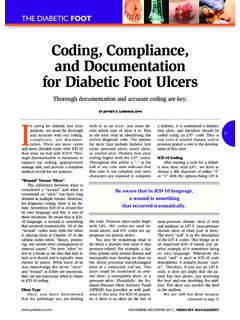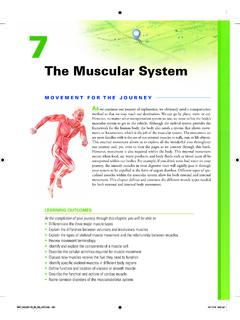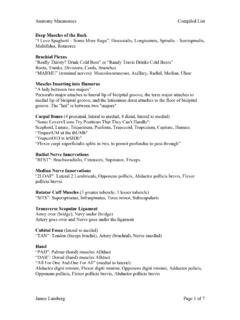Transcription of Understanding the First Ray - Podiatry M
1 109significant since it intersects the transverse and medial longitudinal Otto F. Schuster in the First text devoted to foot orthopaedics stat-ed that the First metatarsal is the Functional Anatomy The First ray is a single sup-port unit comprising the distal end segment of a closely packed medi-al longitudinal arch whose proper function is critical in allowing the chief load-bearing segment of the human foot to accept body weight during static stance and to with-stand ground reactive forces during ambulation (Figure 1, Table 1).1 4 It is composed of the First meta-tarsal and internal cuneiform. The location of this articulation is Welcome to Podiatry Management s CME Instructional program. Our journal has been approved as a sponsor of Con-tinuing Medical Education by the Council on Podiatric Medical Education. You may enroll: 1) on a per issue basis (at $ per topic) or 2) per year, for the special rate of $210 (you save $50).
2 You may submit the answer sheet, along with the other information requested, via mail, fax, or phone. You can also take this and other exams on the Internet at If you correctly answer seventy (70%) of the questions correctly, you will receive a certificate attesting to your earned credits. You will also receive a record of any incorrectly answered questions. If you score less than 70%, you can retake the test at no additional cost. A list of states currently honoring CPME approved credits is listed on pg. 144. Other than those entities currently accepting CPME-approved credit, Podiatry Management cannot guarantee that these CME credits will be acceptable by any state licensing agency, hospital, managed care organization or other entity. PM will, however, use its best efforts to ensure the widest acceptance of this program possible. This instructional CME program is designed to supplement, NOT replace, existing CME seminars. The goal of this program is to advance the knowledge of practicing podiatrists.
3 We will endeavor to publish high quality manu-scripts by noted authors and researchers. If you have any questions or comments about this program, you can write or call us at: Podiatry Management, Box 490, East Islip, NY 11730, (631) 563-1604 or e-mail us at An answer sheet and full set of instructions are provided on pages 144-146. EditorContinued on page 110 Goals and Objectives After reading this CME the practitioner will be able to: 1) Understand normal and abnormal function of the First ray with special emphasis on its integral role in medial longitudinal arch function and hypermobility. 2) Acquire knowledge of the various etiologic factors that result in First ray hypermobility. 3) Appreciate its normal and abnormal motion along with its attendant bio and pathomechanics. 4) Become familiar with vari-ous methods to subjectively and objectively identify its /ORTHOTICS & 2016 | Podiatry MANAGEMENT Understanding the First RayHere s a review of its normal and abnormal function, identification, and clinical JOSEpH C D AMICO, DpM The effectiveness of this tendon on First ray stabili-ty is influenced by its direction of pull and application of force, which in turn is determined by the position of the subtalar and midtarsal 14 In a normal func-tioning foot, contraction of the peroneus longus results in a lateral and plantarward pull on the First This application of force is enhanced during supination, creating a mechanical advantage, thereby restricting dorsal excursion of the First ray.
4 In a pronated foot due to an altered cuboid posi-tion, the pulley system is significantly diminished and peroneus longus contraction is unable to stabilize the First ray with resultant First ray instability and dorsal migration (Figure 3). The tibialis anticus acts con-shortest, by far the strongest and most important weight-bearing point in the The fact that it is the shortest metatarsal forces it to plantarflex during propulsion in order to keep it in contact with the sup-porting surface. The First metatarsal has an inclination angle of 15 25 degrees, which is the greatest of all the During static stance the First metatarsal carries 40% of body Ligaments surrounding the joint stabilize the First metatarsal-cuneiform , 9 Ligamentous sup-port and stability is further enhanced and assisted by the anterior and posterior tibial tendons and most importantly by the peroneus longus tendon (Figure 2, Table 2).
5 Duchenne recognized the importance of func-tional stability of the First ray and noted its dependence on agonist-antagonist muscle The peroneus longus course runs obliquely through the cuboid canal from posterior and lateral to anterior and medial and inserts into the lateral aspect of the First metatarsal base and medial cuneiform. peroneus longus contraction results in significant eversion of the First metatarsal base, thereby locking the medial cuneiform into the medial column. John-son and Christensen attributed + degrees to First metatarsal eversion and +/- degrees of eversion of the internal cuneiform to peroneus lon-gus 2016 | Podiatry MANAGEMENT 110 ContinuingMedical EducationORTHOTICS & BIOMECHANICSF irst Ray (from page 109)Continued on page 111 Figure 1: The medial longitudinal arch with the First ray as its distal anchor-ing segment. Resist ground reactive forces Maintain medial longitudinal arch integrity during midstance supination Allow First metatarsal head to plantarflex at heel lift Allow acceptance of medially shifting body weight during propulsion without forefoot de-stabilization Provide medial stability for propulsive phase rigid lever mechanismTABLE 1: First Ray FunctionFigure 3: First Ray Hypermobility Due to excessive pronation the pero-neus longus having lost its mechanical advantage along with the flexor hal-lucis longus and brevis is unable to stabilize the First ray as a result ground reactive forces produce dorsal 2.
6 First Ray Stability Assisted by the windlass effect of the plantar fascia along with rearfoot supination the First ray is stabilized by joint com-pressive forces and the flexor hallucis longus and brevis as well as perone-us longus tendons allowing plantarflexion of the First metatarsal below the level of the lesser First metatarsal has an inclination angle of 15-25 degrees, which is the greatest of all the to absorb shock, adapt to terrain and begin to accept and support body weight (Figure 4). As the load on the foot becomes more vertical during the stance phase and the calcaneus and metatar-sals are pressed into the ground, the medial longitudinal arch now functions in a truss-like fashion (Figure 5). Aided by the windlass mechanism tightening the plantar fascia, the truss model relies on normal First junctively with the peroneus longus , assisting it in the maintenance of propulsive phase medial longitudinal arch Sesamoid stabilization is also necessary for proper First ray function and is achieved via the flexor hallu-cis longus and brevis tendons.
7 First ray stabilization is aided by bone-to-bone contact and the resultant compressive forces within the joint, enabling this vital pedal segment to resist propulsive phase gravitational forces so it does not become mobile at a time when it should be Additionally and significantly, the windlass effect of the plantar fascia reinforces medial longitudinal arch stability and according to Huang, et al. provides the highest relative contribution to arch stability, followed by the plantar ligaments and spring , 16, 18 The ability of the foot to absorb shock, adapt to terrain irregularities, as well as accept the weight of the superstructure as it passes over it has been likened to a curved beam and , 18 22 The curved beam, repre-senting the medial longitudinal arch, functions in early 111 ContinuingMedical EducationORTHOTICS & BIOMECHANICSF irst Ray (from page 110)Continued on page 2016 | Podiatry MANAGEMENT First metatarsal plantarflexion below the level of the lesser metatarsals peroneus longus , flexor hallucis longus and brevis stabilization Flexor hallucis brevis fusion with ab and ad-ductor hallucis forming synergistic tri-directional stabilization Normal sesamoid function Plantar fascia effect Rearfoot supinationTABLE 2.
8 First Ray Stability RequirementsFigure 4: Early stance curved beam medial longitudinal arch functional 5: With the calcaneus and metatarsals pressed into the ground and aided by the plantar fascia the medial longitudinal arch functions in a truss-like fashion as body weight moves forward over the supporting foot. A stable First ray is necessary for its proper curved beam representing the medial longitudinal arch functions in early stance to absorb shock, adapt to terrain and begin to accept and support body static stance the First metatarsal carries 40% of body to function to enable it to act as a stable pillar for the medial longitudinal As noted by Rush, et al., the windlass mechanism is more efficient when the hallux, sesamoid apparatus, and First metatarsal are in correct alignment. In fact, there is a 26% increase in First metatarsal plantarflexion with the First MPJ in cor-rect alignment vs. a deviated The medial longitudinal arch also provides the Achilles tendon with a long lever arm to act on the forefoot enhancing a stable propulsive First Ray Hypermobility First ray stability is critical in controlling the struc-tural integrity of the , 13, 21, 23 26 Hypermobility is generally described as excessive range of motion in a A more appropriate functional definition of hypermobility is movement of a part at a time when it should be , 23 25 Dudley J.
9 Morton, a Columbia University anatomist, in 1928 was the First to describe First ray hypermobility and instability of the metatarso-cuneiform joint in the sagittal Hypermobility of the First ray is a destructive pro-cess caused by compensatory subtalar and midtarsal joint pronation due to compensation for inherent phy-logenic and ontogenically-induced characteristics and structural imperfections (Table 5, Figure 6).13, 23 25, 28 30 First ray hypermobility collapses the structural frame-work of the medial longitudinal arch, thereby dimin-ishing the ability of the foot to become a rigid lever necessary for propulsion (Figures 7a, b, c). Altered First ray biomechanics with accompanying 2016 | Podiatry MANAGEMENT 112 ContinuingMedical EducationORTHOTICS & BIOMECHANICSF irst Ray (from page 111)Figure 7a: Early Midstance Note the navicular-cuneiform relationship as well as the compact nature of the First metatarsal-cuneiform 7b: Late Midstance Note the significant plantarward divergence of the navicular-cuneiform articulation vs.
10 The unchanged sagittal plane relationship of First metatarsal and 6: First Ray HypermobilityFigure 7c: Propulsion Continuing pronounced pathologic divergence of the navicular-cuneiform articulation accentuated by internal limb rotation while the First metatarsal-cuneiform segment remains a normal functioning foot, contraction of the peroneus longus results in a lateral and plantarward pull on the First on page 113to plantigrade locomotion was the development of the peroneus longus and brevis from anterior to the ankle axis of motion to posterior, changing its function from dorsiflexor to plantar-flexor, and assuming a propulsive function. Secondarily, as a result of increased forefoot stresses, the peroneus longus tendon migrated across the entire foot to act as a tie piece, maintaining the medial lon-gitudinal arch against depression. Steindler emphasizes the wander-ing of the peroneus longus across the plantar aspect of the foot as a significant developmental factor in-cident to the loss of opposability of the great Since ontogeny recapit-ulates phylogeny, any delay or arrest of development or reversion to type regresses foot structure.









